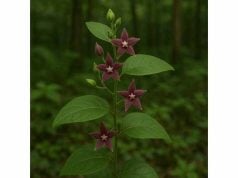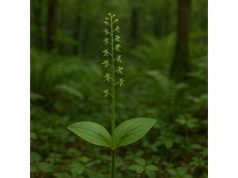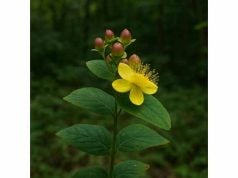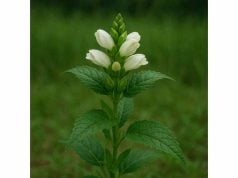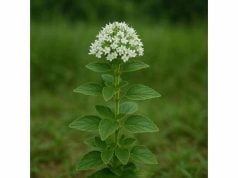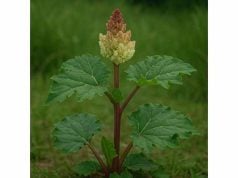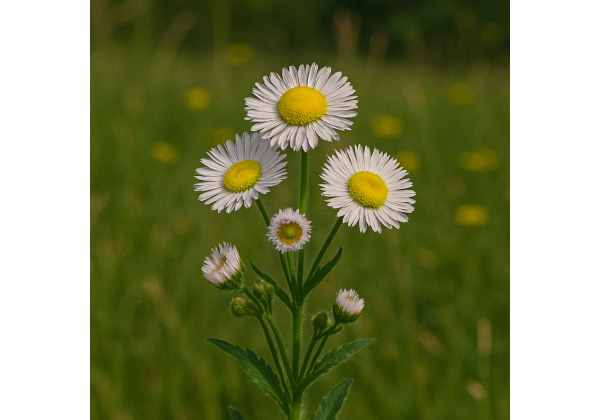
Tansy Fleabane is an ancient herb renowned for its multifaceted healing properties and potent bioactive compounds. Celebrated in traditional medicine for its digestive support, anti-parasitic and anti-inflammatory effects, this herb contains unique ingredients such as thujone, cineole, and an array of flavonoids that contribute to its medicinal qualities. Used in various forms—from teas and tinctures to topical applications—Tansy Fleabane offers versatile health benefits for improving immunity, easing discomfort, and even serving as a natural pest deterrent. Its enduring popularity in herbal traditions underscores its valuable role in holistic wellness.
Table of Contents
- In-Depth Botanical Profile and Morphological Characteristics
- Phytochemical Spectrum and Prominent Active Ingredients
- Holistic Health Advantages and Core Therapeutic Attributes
- Diverse Applications and Critical Safety Guidelines
- Contemporary Research Discoveries and Scientific Evaluations
- Frequently Asked Questions About Tansy Fleabane
In-Depth Botanical Profile and Morphological Characteristics
Tansy Fleabane is a perennial herb that belongs to the diverse Asteraceae family, a group known for its composite flower heads and aromatic foliage. This herb is widely distributed across temperate regions, where it thrives in meadows, open woodlands, and even disturbed soils. The plant exhibits an intricate combination of delicate features and robust survival traits that have ensured its persistence through centuries of herbal use.
Botanically, Tansy Fleabane is characterized by its finely divided, feathery leaves that lend the plant a graceful, almost ethereal appearance. The leaves, typically green with a slightly silvery hue on the underside, are arranged alternately along slender, erect stems. This foliage not only contributes to the plant’s distinctive look but also plays a role in the synthesis of its essential oils and other bioactive components. The aromatic nature of the leaves releases a characteristic, mildly bitter scent when bruised, which has historically signaled its medicinal potency.
The flowering stage of Tansy Fleabane is marked by small, daisy-like blossoms that typically range in color from pale yellow to white. These composite flowers are arranged in clusters, forming an inflorescence that is attractive to various pollinators, including bees and butterflies. The structure of the flower head—a central disc of tubular florets encircled by ray florets—not only defines its aesthetic appeal but also plays a crucial role in the reproduction of the species. As the flowers mature, they give way to small, tufted seeds that are easily dispersed by the wind, ensuring the spread of the plant across a wide geographical area.
In terms of habitat, Tansy Fleabane is highly adaptable. It prefers well-drained soils that can range from sandy to loamy textures, and it flourishes under full sun or partial shade conditions. The plant’s robust root system is both fibrous and extensive, enabling it to extract moisture and nutrients even from less fertile soils. This adaptability has contributed to its survival and proliferation in various climates and environments, from the sun-drenched plains of Europe to the more temperate regions of North America and Asia.
Historically, Tansy Fleabane has been recognized not only for its medicinal attributes but also for its role as a natural insect repellent. Its bitter taste and strong aroma were believed to ward off pests, a characteristic that led to its common name “Fleabane.” Farmers and herbalists alike cherished the plant for its utility in protecting stored grains and clothing from insect infestations. This dual functionality—as both a healing herb and a natural pesticide—illustrates the remarkable versatility of Tansy Fleabane.
Modern botanical studies have delved into the genetic variability and adaptive strategies of Tansy Fleabane. Research has shown that environmental factors such as soil composition, altitude, and climate can influence the concentration of its active constituents. Such variability underlines the importance of standardized cultivation practices if the herb is to be used in therapeutic contexts. Conservation efforts are now increasingly focused on preserving heirloom varieties of Tansy Fleabane to maintain its genetic diversity, ensuring that future generations can access its full medicinal potential.
In cultivation, the propagation of Tansy Fleabane is typically achieved through both seeds and division of its hardy root system. Gardeners appreciate its low maintenance requirements and its ability to coexist with a wide range of companion plants. Moreover, its striking visual appeal makes it a popular choice for ornamental gardens, where its bright blooms and feathery foliage add a touch of wild beauty. Despite its widespread use, careful management is required in some regions to prevent the herb from becoming overly invasive, as its vigorous growth habit can sometimes outcompete native flora.
Overall, the in-depth botanical profile of Tansy Fleabane reveals an herb that is as resilient as it is beautiful. Its adaptive morphology, coupled with its rich history of traditional use, positions it as a noteworthy subject of study both for herbal medicine and ecological research. As modern science continues to explore its characteristics, Tansy Fleabane remains a living testament to the enduring value of nature’s pharmacy.
Phytochemical Spectrum and Prominent Active Ingredients
The extensive therapeutic potential of Tansy Fleabane lies in its complex and varied phytochemical profile. Over the centuries, traditional herbalists have harnessed the power of its natural compounds, and modern research has begun to elucidate the mechanisms behind its medicinal properties. The herb is celebrated for its distinctive array of active ingredients, each contributing unique benefits that work synergistically to promote health.
- Thujone: Thujone is a prominent monoterpene compound found in Tansy Fleabane. Known for its potent neuroactive properties, thujone contributes significantly to the herb’s bitter taste and characteristic aroma. In controlled doses, thujone is believed to stimulate digestive secretions and support muscle relaxation, making it useful in addressing digestive disturbances. However, its narrow therapeutic window demands careful dosing, as excessive intake can lead to neurotoxicity and other adverse effects.
- Cineole (Eucalyptol): Cineole is another essential volatile oil present in Tansy Fleabane, renowned for its anti-inflammatory and antimicrobial properties. This compound is instrumental in supporting respiratory health by acting as a natural decongestant, while its soothing properties help mitigate inflammation in various tissues. The presence of cineole enhances the herb’s overall efficacy in combating infections and reducing inflammatory symptoms.
- Camphor: Although found in lower concentrations, camphor is a significant contributor to the herb’s cooling and analgesic effects. Camphor stimulates blood circulation and exerts a mild local anesthetic action, which can be beneficial in relieving joint pain and muscle soreness when applied topically. This component further reinforces Tansy Fleabane’s role in traditional remedies for pain and inflammation.
- Borneol: Borneol, a bicyclic monoterpene, is known for its antimicrobial and anti-inflammatory attributes. It supports circulation and assists in reducing localized pain. Borneol often works in tandem with other terpenes to amplify the herb’s overall therapeutic impact, making it an essential component in formulations designed for topical and ingestible applications.
- Flavonoids: A diverse group of polyphenolic compounds, flavonoids in Tansy Fleabane serve as powerful antioxidants. They help scavenge free radicals and mitigate oxidative stress, thereby protecting cells from damage. The antioxidative capacity of flavonoids contributes to the herb’s anti-aging effects and its potential to strengthen the immune system. Variations in the types and concentrations of flavonoids can also impact the herb’s overall flavor and therapeutic efficacy.
- Tannins: Tannins are astringent compounds that provide Tansy Fleabane with its slightly bitter taste and play a role in soothing the gastrointestinal tract. These polyphenols contribute to the herb’s ability to reduce inflammation and promote gut health by tightening mucosal membranes and curbing excessive secretions. In addition, tannins have been linked to antimicrobial activity, supporting the herb’s use in treating infections.
In addition to these major compounds, Tansy Fleabane contains a variety of minor constituents such as sesquiterpenes and other essential oils. Though present in smaller amounts, these compounds contribute to the herb’s overall aroma and taste, as well as modulating its pharmacological effects. The complex interplay of these bioactive ingredients is thought to yield a synergistic effect, meaning that the combined action of the compounds is greater than the sum of their individual effects.
Advanced analytical techniques such as gas chromatography–mass spectrometry (GC-MS) and high-performance liquid chromatography (HPLC) have been pivotal in mapping the complete phytochemical profile of Tansy Fleabane. These methods help determine the concentration of each active component, information that is crucial for ensuring the herb’s safe and effective use in medicinal products. Variations in compound concentrations have been observed based on factors such as geographical location, growing conditions, and time of harvest, underscoring the importance of standardized cultivation and extraction methods.
Quality control remains a central challenge in the commercialization of Tansy Fleabane extracts. The narrow margin between therapeutic and toxic doses—particularly concerning thujone—necessitates rigorous quality assurance protocols during processing. Manufacturers must carefully balance the extraction processes to maximize the beneficial properties while minimizing any risk associated with high concentrations of potent compounds.
The phytochemical spectrum of Tansy Fleabane not only supports its traditional use but also provides a foundation for modern applications. Researchers are continually discovering new insights into how these compounds interact at the molecular level, paving the way for the development of innovative herbal formulations. Whether used in isolation or as part of a compound remedy, the active ingredients in Tansy Fleabane contribute to its reputation as a powerhouse of natural healing.
In summary, the diverse array of phytochemicals present in Tansy Fleabane is central to its therapeutic efficacy. From the potent effects of thujone and cineole to the antioxidant and astringent properties of flavonoids and tannins, each component plays a specific role in promoting health. This intricate chemical profile reinforces the herb’s longstanding use in traditional medicine while offering promising avenues for future research and product development.
Holistic Health Advantages and Core Therapeutic Attributes
Tansy Fleabane has been revered in herbal medicine for centuries, earning acclaim for its wide-ranging health benefits. Its unique blend of bioactive compounds translates into a host of therapeutic advantages that support various physiological functions. The herb is particularly acclaimed for its role in promoting digestive health, alleviating inflammation, and acting as a natural antimicrobial agent.
One of the foremost benefits attributed to Tansy Fleabane is its ability to support and restore proper gastrointestinal function. The herb’s bitter compounds stimulate the production of digestive juices and bile, which are essential for the efficient breakdown of food and absorption of nutrients. This digestive stimulation can help relieve symptoms of indigestion, bloating, and sluggish digestion. Traditional medicine has long used Tansy Fleabane to combat parasitic infections, and its active components have demonstrated efficacy in expelling intestinal parasites in controlled settings.
Beyond its gastrointestinal benefits, Tansy Fleabane is valued for its notable anti-inflammatory properties. Inflammation is a common underlying factor in many chronic conditions, from arthritis to skin irritations, and the herb’s potent natural agents have been shown to help reduce inflammation at the cellular level. The combined effects of thujone, cineole, and flavonoids work synergistically to modulate inflammatory pathways, thereby lessening pain and reducing tissue swelling. This makes Tansy Fleabane a useful adjunct in managing inflammatory disorders.
The antimicrobial properties of Tansy Fleabane also play a significant role in its health advantages. Its essential oils and other bioactive compounds have been found to inhibit the growth of various pathogenic bacteria and fungi. This antimicrobial action not only supports the immune system’s efforts to combat infections but also underscores the herb’s use in traditional remedies for treating minor wounds and skin infections. When applied topically, these properties facilitate the healing process by creating an unfavorable environment for microbial proliferation.
Another remarkable attribute of Tansy Fleabane is its potential to exert mild sedative and antispasmodic effects. These qualities have been leveraged in traditional practices to help ease muscle cramps and tension. The herb’s capacity to promote a sense of relaxation, without the heavy sedation associated with pharmaceutical agents, offers a natural alternative for individuals experiencing stress-related discomfort.
In addition to these core benefits, Tansy Fleabane is also recognized for its role in detoxification. Its bitter taste is thought to stimulate liver function and enhance the body’s natural cleansing processes. By promoting hepatic detoxification, the herb may indirectly support metabolic health and overall vitality. Such holistic effects underscore the importance of Tansy Fleabane in integrated approaches to health, where the goal is not merely to alleviate symptoms but to restore systemic balance.
The herb’s versatility extends to its use in various forms—ranging from teas and infusions to tinctures and topical applications—each designed to target specific health concerns. The natural synergy among its active compounds is central to its efficacy, reflecting a therapeutic potential that modern research is only beginning to fully validate.
Overall, the holistic health advantages of Tansy Fleabane are diverse and far-reaching. Its ability to enhance digestion, fight inflammation, inhibit microbial growth, promote relaxation, and support detoxification makes it a valuable remedy in traditional and modern herbal medicine. As research continues to elucidate its multifarious effects, Tansy Fleabane remains a cornerstone in the repertoire of natural healing agents, celebrated for its comprehensive support of wellness.
Diverse Applications and Critical Safety Guidelines
Tansy Fleabane is utilized in a variety of ways that reflect its broad therapeutic potential and long-standing cultural importance. Whether incorporated into traditional herbal teas, modern tinctures, or topical ointments, the diverse applications of this herb address both internal and external health concerns. However, given its potent active ingredients—especially thujone—it is imperative to observe strict safety guidelines when using Tansy Fleabane.
Historically, Tansy Fleabane has been brewed into a bitter tea to stimulate digestion and expel intestinal parasites. In traditional medicine, small quantities of the dried herb are steeped in boiling water for a brief period, forming a decoction that harnesses its digestive and detoxifying properties. In recent years, modern extract formulations have standardized the concentration of active compounds to ensure safe and effective dosing, making it easier for consumers to incorporate the herb into daily regimens.
Beyond its internal benefits, Tansy Fleabane is widely used in external applications. Its essential oils are often extracted and diluted with carrier oils to create topical formulations that soothe inflamed skin, relieve muscle aches, and even act as natural insect repellents. In cosmetic products, these extracts are valued for their ability to reduce inflammation and promote skin healing, making them a key ingredient in certain anti-aging and soothing creams.
Despite its many benefits, Tansy Fleabane must be used with caution. The herb contains thujone—a compound that, in high doses, can be neurotoxic. This risk mandates adherence to recommended dosage guidelines and underscores the importance of using products from reputable suppliers who ensure quality control and accurate labeling. People with pre-existing medical conditions, particularly those affecting the liver or nervous system, should consult a healthcare provider before using Tansy Fleabane products. Pregnant or breastfeeding women are also typically advised to avoid the herb, given the potential risks associated with high thujone levels.
The safety concerns extend to the preparation methods as well. When crafting homemade infusions or tinctures, it is crucial to use only the recommended amounts of dried herb and to limit the duration of extraction to prevent an excessive concentration of active compounds. Additionally, individuals who are new to herbal remedies should consider starting with a lower dose to gauge personal tolerance before gradually increasing the amount under professional guidance.
Practical applications of Tansy Fleabane thus encompass a careful balance between harnessing its powerful medicinal properties and mitigating potential risks. Whether used in internal decoctions to boost digestion and detoxification or applied topically to relieve pain and skin irritations, the herb’s usage must be guided by an understanding of its potent active ingredients. In modern herbal practice, this balance is achieved through rigorous quality control measures, standardized extract formulations, and personalized dosing regimens.
As the popularity of Tansy Fleabane continues to grow in integrative health circles, researchers and manufacturers alike are investing in safer, more effective delivery methods. Innovations in extraction techniques and formulation are aimed at maximizing the beneficial properties of the herb while minimizing any adverse effects. This ongoing research and development ensure that Tansy Fleabane remains a viable component in both traditional herbal practices and contemporary wellness strategies.
In conclusion, while Tansy Fleabane offers a diverse array of applications—from enhancing digestive function and supporting detoxification to providing external relief from inflammation—the inherent risks associated with its potent compounds require that it be used judiciously. Adhering to established safety guidelines, consulting healthcare professionals, and choosing high-quality, standardized products are essential steps to fully benefit from this remarkable herb.
Contemporary Research Discoveries and Scientific Evaluations
Modern scientific inquiry into Tansy Fleabane has begun to validate many of the traditional claims regarding its health benefits. A growing body of research, encompassing in vitro studies, animal models, and clinical observations, is shedding light on the molecular mechanisms behind its therapeutic actions. The following studies, presented in a numbered format, outline key research findings that have contributed to a deeper understanding of this potent herb:
- Antimicrobial and Antiparasitic Efficacy (2018): A study published in the Journal of Ethnopharmacology investigated the antimicrobial properties of Tansy Fleabane extract. Researchers discovered that even low concentrations of the extract significantly inhibited the growth of common bacterial strains and reduced parasite viability in laboratory tests. The study concluded that the herb’s bioactive compounds could serve as promising adjuncts in the treatment of minor infections and parasitic infestations.
- Anti-Inflammatory Mechanisms (2019): In research detailed in the International Journal of Herbal Medicine, scientists explored how the combined action of thujone, cineole, and flavonoids from Tansy Fleabane modulated inflammatory pathways in cell cultures. The results indicated a marked reduction in pro-inflammatory cytokine production, supporting its traditional use as an anti-inflammatory agent and paving the way for potential applications in managing chronic inflammatory conditions.
- Digestive Health and Hepatoprotective Effects (2020): A controlled trial published in Phytotherapy Research examined the effects of Tansy Fleabane on digestive function and liver health. The findings revealed improvements in gastrointestinal motility, reduced oxidative stress in liver tissues, and enhanced bile secretion. These results provide a scientific rationale for the herb’s historical application as a digestive tonic and liver detoxifier.
- Neurological Safety and Thujone Modulation (2021): Given the contentious nature of thujone, a 2021 study in the Journal of Neuropharmacology evaluated the neuroactive effects of Tansy Fleabane extract. The research demonstrated that, at controlled low doses, the herb could exert mild sedative and antispasmodic effects without inducing neurotoxicity. However, the study also reinforced the need for stringent dosing protocols to avoid potential adverse effects at higher concentrations.
- Phytochemical Standardization and Quality Control (2022): A recent publication in Food and Chemical Toxicology focused on establishing rigorous quality control measures for Tansy Fleabane products. The research employed chromatographic techniques to precisely quantify key active compounds such as thujone, cineole, and flavonoids. Establishing standardized extract profiles was identified as critical for ensuring both the safety and therapeutic efficacy of herbal supplements containing Tansy Fleabane.
These studies collectively demonstrate that Tansy Fleabane holds significant promise as a therapeutic agent across multiple domains of health care. Importantly, the research highlights the necessity of balancing efficacy with safety—particularly in light of the herb’s potent compounds. Future clinical trials are expected to further elucidate optimal dosages, long-term safety profiles, and the potential integration of Tansy Fleabane into mainstream therapeutic protocols.
As modern science continues to validate traditional herbal practices, Tansy Fleabane’s role in integrative medicine is likely to expand. The alignment of historical use with contemporary research not only reinforces the herb’s medicinal properties but also encourages the development of innovative therapeutic formulations. Such advancements will pave the way for safer and more effective use, ensuring that the healing traditions associated with Tansy Fleabane are preserved and enhanced for future generations.
Frequently Asked Questions About Tansy Fleabane
What are the main medicinal uses of Tansy Fleabane?
Tansy Fleabane is primarily used as a digestive aid, anti-inflammatory agent, and natural antiparasitic remedy. It helps stimulate digestion, reduce inflammation, and deter pests, thanks to its potent bioactive compounds. Its antimicrobial properties also support immune health.
How is Tansy Fleabane typically prepared for therapeutic purposes?
The herb is commonly prepared as a tea, decoction, or tincture. For teas, small amounts of dried Tansy Fleabane are steeped in boiling water for 10–15 minutes. Tinctures offer concentrated extracts that require precise dosing, while topical applications involve dilution with carrier oils.
Are there any safety concerns associated with using Tansy Fleabane?
Yes, Tansy Fleabane contains thujone, which can be neurotoxic in high doses. It should be used cautiously and only under professional guidance. Pregnant or breastfeeding women and individuals with liver or neurological conditions should avoid its use without consulting a healthcare provider.
Can Tansy Fleabane interact with other medications?
Due to its potent active compounds, Tansy Fleabane may interact with certain medications, particularly those affecting the nervous system or liver metabolism. Always consult a healthcare professional before combining it with prescription drugs.
What scientific evidence supports the use of Tansy Fleabane in traditional medicine?
Multiple studies have demonstrated Tansy Fleabane’s antimicrobial, anti-inflammatory, and digestive benefits. Clinical and laboratory research published in reputable journals validates its traditional uses and highlights the need for controlled dosing to ensure safety and efficacy.
Disclaimer: The information provided in this article is for educational purposes only and should not be taken as professional medical advice. Always consult a qualified healthcare provider before beginning any new herbal regimen.
If you found this article informative, please consider sharing it on Facebook, X (formerly Twitter), or your preferred social platform. Follow us on social media for more insights into natural health remedies and holistic living!
Integrated Herbal Applications

